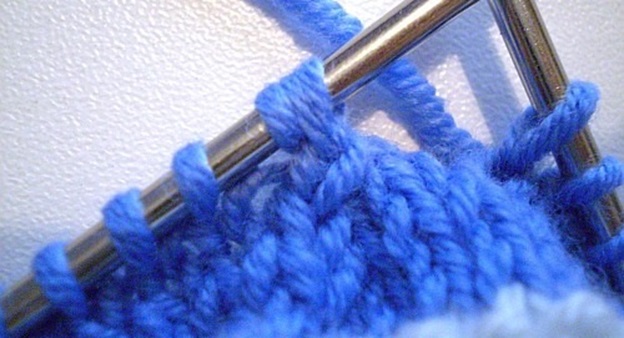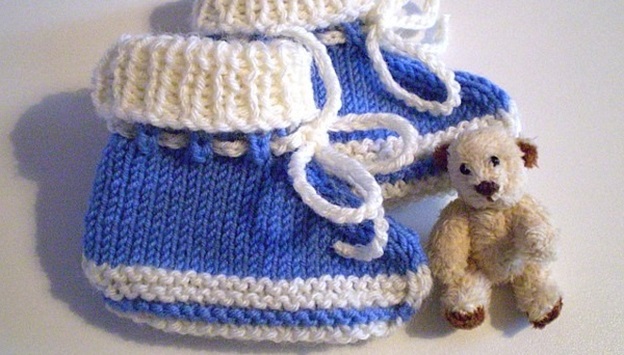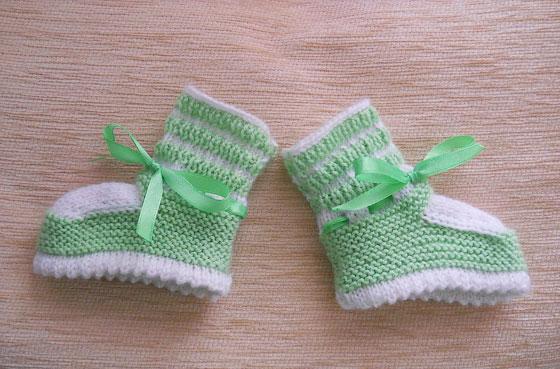We knit baby booties with knitting needles for kids on photos and video MK
Content
- Video knitting lessons knitting lessons from black and white yarn
- We knit baby booties with knitting needles for a newborn
- Video: Booties sneakers for girls
If you are just starting to learn how to knit,And want to make a baby fashionable booties keds, then you can take this lesson. The master class shows the technique of making shoes for newborns, with photos, descriptions and videos. In the lesson, the scheme of work is also provided to successfully connect the baby's booties. Such little kedikas are very popular among young mummies, so many of them will want to learn how to knit sneakers of this model with knitting needles. The model of the pinets, made in the form of a shoe, knits with the needles rather quickly, and the coloring is chosen at will. It is better to tie two-tone sneakers, because they are more like real kediks. In addition, consider the rules for combining clothing and similar shoes. Knitted small knuckles and very effective booties kedy look best in combination with even trousers, or a classic suit, as well as a children's shirt. So, we begin the lesson on knitting with knitting needles of children's shoes, reminiscent of sneakers.






This master class has photos attached to it, from which it can be concluded that the children's booties with knitting needles warm both the legs of the baby and decorate the set of his clothes.

Appearance of children's pinets with stylish andspectacular. Any mummy can easily tie the children's sneakers, choosing a combination of color, size and details of the design. It is enough to measure the length of the baby's leg, and you can start knitting with knitting needles. In the photo above, a combination of white with a blue color is chosen, but there are other options. Choose white and green, or white and orange colors. According to the description, small sneakers are formed with spokes using patterns that are fairly uniform, without reliefs. Pay attention to the variety of colors that can be combined for such a pin.

And now look at the previously mentioned combinations of colors, such as orange and white.

And here's another combination, which was discussed in the lesson, that is, a combination of green with blue, and a blue edging.

Video knitting lessons knitting lessons from black and white yarn
Video master class will tell beginnersNeedlewomen on how to tie baby booties in the form of a sneaker. Requires a thread of white and black color and spokes number two. We will perform the set on spokes with threads of white color, in the number of forty-six units. The first two rows must be connected only by the facial loops. In this case, the first edge should be removed, and the latter should be knitted like the wrong one. In the third P, the cone (H) is satisfied. After it follows 21 face loop (LP), another cape, two LPs, a cape, and again 21 LP. The last H is executed before the edge P. The fourth row (P) is executed by the face loops. In place of the nakidov it is necessary to perform crossed LP so that there are no holes on the canvas. In the next fifth P, the nakids are executed according to the same scheme as in the third. While knitting carefully watch the video. The sixth row is knit LP, like the fourth. In the seventh P we also alternate LPs and nakids. This technique should be connected with twelve rows of spokes. This is the knitting pattern of the sole, which is the basis for shoes called booties.

Having finished the sole, go to the knitting of the rimKnitting needles. For him, we make six P face loops, after which we attach a black thread to the work, and tie two rows. Behind the black stripe, you need to re-connect the white thread, and perform two more R. Now start knitting with the knuckles of the toe of the booties of the sneaker. First we will perform thirty units, after which we begin to knit six P separately, gradually increasing their number by one in each row, and bringing up to twelve. Then we make seven more P, but now with decrements. After that, in the same place, we begin to knit thirteen rows with black threads, carrying out the tongue of booties of the sneaker. In the thirteenth row, it is necessary to reduce the loops at its beginning and end, one at a time. As a result, the rounding of the tongue is obtained, after which we knit another row, and close the tabs of the tongue. The remaining P is divided into three spokes, and we knit twenty-four rows of the back of the pinets with black yarn. In the twenty-fifth P, we perform decrements on the edges along the loop, and in the twenty-sixth we close the loops. At the final stage, it remains to tie the tongue and back part of the crochet, using columns without a crochet or with a crochet. Then we sew two halves of the sole. You will need a hook to make the shoelaces.
We knit baby booties with knitting needles for a newborn
The master class will serve as a fixative forKnitting pinets kedikov. The model is knitted with two spokes. Technique on step-by-step photos will help beginners knitters to easily cope with needlework, and tie booties in the form of kediks. For knitting a mixed yarn made of wool and acrylic, cotton and acrylic, or plain wool, is suitable. Prepare knitting needles number three, and we will knit sneaker booties with facial loops, purl loops and nakidami. Note also that the size of the foot of the newborn is eight centimeters in the age of up to three months. From three to six months the length of the leg is equal to nine centimeters. Six-month-old child knit booties in length 11 centimeters. A one-year-old kid will need sneakers about thirteen inches long. Take for example the length of the pin 11 centimeters, and we collect thirty-two loops for it with white threads.

Then make twelve rows. From the front part of the fabric we knit the hinges. Here it is necessary to perform additions in each row. We will add P at the beginning and end of P, and also near the two central loops, before and after them, two units each. It is desirable to plan the center of the canvas with a thread of another shade. On the wrong side of the fabric we knit this way. We will knit P face, except for two central and two extreme units. We bind these P with the purl. As a result, we get this form of cloth.

Let us dwell in more detail on what course of work will be performed in the process of needlework in the first four rows:
- In the first P all P are facial, except for the edge, of which the first is removed, and the latter is knitted as an IP;
- In the second P we remove the edge, then we knit the PI,After which the hinges are only facial. We bind the center to the center, then the two central ones are purl. They should be followed by LP, except the last two, which we knit as IP;
- After the marginal in the third P picks up the facialCrossed P from the broach (without the crochet). Then П should be facial, and before and after the middle П we execute one added P. At the end of P add one more faceted crossed П from the broach. This added P is executed before the last edge;
- The fourth P is knitted in the same way as the second.
As can be seen from the description, the added P existOnly in odd P, using P from the broach. Even we knit without adding. The next two P are tied with a blue color, the pattern is a smooth surface. After that, the work will continue with the same pattern. At the same time, on the side of odd P, it is necessary to perform the following actions. Not reaching three P to the center, make two П together with displacement. This means that the second P is placed before work on an additional spoke or pin. Then two LPs are knit, and two П together face.

In even P, on the side of the IP, for three loops to the center, we make two PIs along with the displacement. After this, two PIs follow, and two together with a purl.
This technique should be followed untilOnly half of the units remain from the initial quantity. To enter the shoelaces, we need to perform the next row. We knit a report where two LPs alternate with a crochet. After this, we begin to make a cuff for the shoe, using white thread. We will perform an elastic band, where the LP alternate with the FE.

The height of the rubber band is approximately equal to ten centimeters, after which the row will be closed. Cut yarn, except for the length that is needed for the seam.
Sewing the product, after which we tie the crochet crochet, a length of forty centimeters. We put it in the holes of the sneaker, and we tie it.

Video: Booties sneakers for girls





